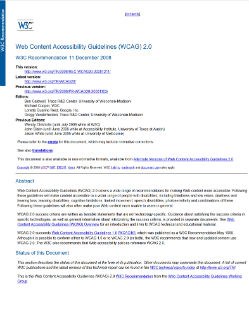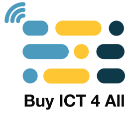
‘WCAG 2.0’ is not as long as the other Priority Standards in this section, because it is more targeted, covering technology relating to web and electronic content accessibility. It is a detailed technical ‘guideline’ that has been widely adopted, and is now also an international standard (ISO/IEC 40500). It was produced by the World Wide Web Consortium Web Accessibility Initiative (W3C-WAI). It has direct applicability to anyone developing websites and/or electronic content. WCAG 2.0 is actually a subset part of both of the other Priority Standards in this subsection (EN 301 549, and Section 508). This 2008 version is the revised version of the precursor WGAG 1.0 from 1999.
The Standard describes how various types of mainstream websites (internet and intranet) and other digital content such as electronic documents, mobile interfaces and related web technologies should behave in order to be accessible to people with disabilities. It does this through criteria aimed at making interfaces and their content perceivable, operable, understandable, and robust.
The primary target audience for this document is web and digital content designers, developers and testers. Having the requirements defined allows a secondary target audience, public procurement policymakers, to reference these standards in their activities. Referencing the standards provides buyers and vendors a shared language and common understanding of what is considered to be ‘accessible’.
There are associated training and toolkit materials available. These materials can help those who work in related aspects, even if they consider themselves to be ‘non-technical’. Procurement personnel, marketing and sales personnel, managers, and others may find it beneficial to first consult these related ‘Understanding and Implementation’ resources, which are provided in the next Section(s) of this Portal.







